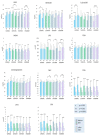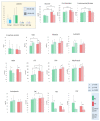Serum Oxidative Status in People with Obesity: Relation to Tissue Losses, Glucose Levels, and Weight Reduction
- PMID: 38001776
- PMCID: PMC10669655
- DOI: 10.3390/antiox12111923
Serum Oxidative Status in People with Obesity: Relation to Tissue Losses, Glucose Levels, and Weight Reduction
Abstract
Background: This work aims to study the effect of reductions in various body mass components on the oxidative, glycemic, and lipid parameters of people with obesity (PWO).
Methods: A total of 53 PWO underwent a six-month individualized low-calorie diet combined with moderate exercise, during which anthropometric, biochemical, and oxidative parameters were measured. Probands were divided into groups based on weight, visceral fat area (VFA), total body water (TBW), and skeletal muscle mass (SMM) losses.
Results: Weight reduction normalizes glycemia, but VFA reduction is less pronounced, while SMM and TBW reductions are more pronounced in patients with higher initial concentrations of glucose and fructosamine. Moreover, changes in oxidative parameters correlate with changes in glucose.
Conclusions: Weight loss, regardless of the reduced tissue, decreases cardiovascular risk. We observed a significant change in almost all parameters related to the redox state. In general, parameters responsible for antioxidant action improved, and markers of oxidative damage decreased. Malondialdehyde, lipid peroxides, and total oxidative status levels can be considered biomarkers reflecting only the current severity of reactive oxygen species genesis processes. When considering the glycemic state, the results are not as clear due to the substantial differences between normoglycemic and hyperglycemic patients. Glycemic status is a factor playing a crucial role in weight reduction.
Keywords: bioimpedance; glycemia; oxidative status; weight loss.
Conflict of interest statement
The authors declare no conflict of interest.
Figures




Similar articles
-
Erythrocyte Oxidative Status in People with Obesity: Relation to Tissue Losses, Glucose Levels, and Weight Reduction.Antioxidants (Basel). 2024 Aug 7;13(8):960. doi: 10.3390/antiox13080960. Antioxidants (Basel). 2024. PMID: 39199206 Free PMC article.
-
Loss of Skeletal Muscle Mass and Intracellular Water as Undesired Outcomes of Weight Reduction in Obese Hyperglycemic Women: A Short-Term Longitudinal Study.Int J Environ Res Public Health. 2022 Jan 17;19(2):1001. doi: 10.3390/ijerph19021001. Int J Environ Res Public Health. 2022. PMID: 35055821 Free PMC article.
-
Relationship of adipokine to insulin sensitivity and glycemic regulation in obese women--the effect of body weight reduction by caloric restriction.Vojnosanit Pregl. 2013 Mar;70(3):284-91. doi: 10.2298/vsp1303284v. Vojnosanit Pregl. 2013. PMID: 23607240
-
[Simple obesity in children. A study on the role of nutritional factors].Med Wieku Rozwoj. 2006 Jan-Mar;10(1):3-191. Med Wieku Rozwoj. 2006. PMID: 16733288 Review. Polish.
-
Visceral adiposity and inflammatory bowel disease.Int J Colorectal Dis. 2021 Nov;36(11):2305-2319. doi: 10.1007/s00384-021-03968-w. Epub 2021 Jun 9. Int J Colorectal Dis. 2021. PMID: 34104989 Review.
Cited by
-
Erythrocyte Oxidative Status in People with Obesity: Relation to Tissue Losses, Glucose Levels, and Weight Reduction.Antioxidants (Basel). 2024 Aug 7;13(8):960. doi: 10.3390/antiox13080960. Antioxidants (Basel). 2024. PMID: 39199206 Free PMC article.
References
-
- World Health Organization Obesity. [(accessed on 6 December 2022)]. Available online: https://www.who.int/news-room/fact-sheets/detail/obesity-and-overweight.
-
- Health Status of Population in Poland in 2019. Główny Urząd Statystyczny. [(accessed on 6 December 2022)]; Available online: https://stat.gov.pl/obszary-tematyczne/zdrowie/zdrowie/stan-zdrowia-ludn....
-
- Zalejska-Fiolka J., Hubková B., Birková A., Veliká B., Puchalska B., Kasperczyk S., Błaszczyk U., Fiolka R., Bożek A., Maksym B., et al. Prognostic Value of the Modified Atherogenic Index of Plasma during Body Mass Reduction in Polish Obese/Overweight People. Int. J. Environ. Res. Public Health. 2019;16:68. doi: 10.3390/ijerph16010068. - DOI - PMC - PubMed
LinkOut - more resources
Full Text Sources

